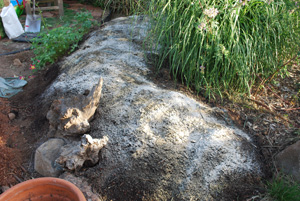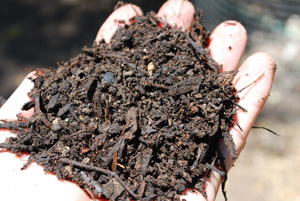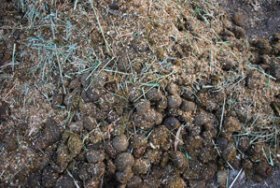Improving Garden Soil by Adding
Bulk Soil Amendments
Improving garden soil takes two things: lots of organic matter, and lots of elbow grease (or a tiller).

|
|
Alfalfa Meal, Feather Meal, Kelp Meal, Oyster Shell Flour, and Greensand © Steve Masley (Click IMAGE to Enlarge) |
At the extremes—a sandy soil that drains too quickly and a clay soil that doesn’t drain—you have to fix the drainage issues first, or nothing good can happen. But even at the extremes, adding organic matter is still the best way to improve garden soil.
This is what “Feed the Soil to Feed the Plants”, the mantra of organic gardeners everywhere, means. When you “feed the soil” by increasing soil organic matter, the soil organisms that break it down multiply, and their waste products provide a “micro-manure” organic fertilizer that’s deposited right at the root hairs of your plants. See The Soil Food Web for more information.
In Clay soils, organic matter improves the pore structure of the soil, increases drainage, and increases soil biodiversity by allowing aerobic processes to take place deeper into the soil horizon. See Improving Clay Soil for structural fixes for drainage problems and other issues of clay soil.
In sandy soil, organic matter slows the rate of drainage, improves moisture retention, and increases the biodiversity of the soil ecosystem. See Gardening in Sandy Soil for solutions specific to sandy soil frustrations.
In acidic soil or alkaline soil, organic matter “buffers” soil pH, reducing swings in pH caused by adding soil amendments. See Changing Soil pH for more information.
C:N Ratios
|
Garden Compost
|
Mushroom Compost
Manures
|
Municipal Compost
If your garden is in the Goldilocks zone, a loam soil, consider yourself lucky. Loam soil has a nice structural balance between sand, silt, and clay. Even if it had no life in it, loam soil would retain moisture—just by the way its particles stack. But because it retains moisture, loam soil usually has a rich and diverse soil ecosystem.
Whether you have a clay soil, sandy soil, or anything in between, improving garden soil always involves adding organic matter. At a minimum, you have to replace some of what you take out of the soil by harvesting vegetables. But what kind of “organic matter” should you add?
For improving garden soil, large amounts of organic matter are needed, and Bulk Soil Amendments are the only way to go.
Bulk Soil Amendments
Bulk soil amendments are added by the truckload, wheelbarrow-load, or bucket-load, depending on how big your garden is. They’re usually a bi-product of local or regional livestock, lumber, or food processing operations.
If you have a small garden, it’s often easiest to buy bagged, composted soil amendments from your local garden center. But if you have a larger garden and access to a truck, you’ll get better materials and a much better price buying bulk soil amendments by the cubic yard, either directly from the source, or from a local soil yard.
When improving garden soil with bulk soil amendments, plan on adding a 3-4” (7-10cm) layer to the soil surface, and mixing it into the soil before planting. The first year or two after starting a garden, you’ll want to lay down at least a 4” (10cm) layer, and cultivate it in.
Many gardeners make the mistake of leaving soil amendments on the surface, instead of mixing them in. If it’s left on the surface, it’s not a soil amendment, it’s a Mulch. Mulches have their own benefits, but for improving garden soil, the particles have to be in contact with soil organisms, so mix them into the soil.
It takes 10 five-gallon (27cm) buckets to lay down a 1” (2.5cm) layer over 100 square feet (3 square meters) of vegetable garden soil. That’s 20-30 buckets to lay down a 2-3" (5-8cm) layer over a 10’ x 10’ (3m x 3m) garden. We’re talking quantity here!
C:N Ratios
|
Garden Compost
|
Mushroom Compost
Manures
|
Municipal Compost
About Carbon-to-Nitrogen (C:N) Ratios
When improving garden soil by adding organic matter, you’ll save yourself a lot of wasted effort if you know something about the carbon-to-nitrogen (C:N) ratios of the materials you’re adding. The table below provides C:N ratios for common waste products and bulk soil amendments.
Don’t let these numbers overwhelm you. What’s important is not the exact numbers, but understanding the difference between high C:N and low C:N materials, and how they affect the soil.
Adding finely-ground, high-carbon materials can result in nitrate depletion, at least in the short term.
Where a range is given it’s because of variability in the material. For example, young, green plants have higher levels of nitrogen than older, stalky plants, so the C:N ratio of hay varies depending on how old the plant was when it was cut. In manures, variability comes from the amount and type of bedding that’s mixed with the manure.
| Garden Material | C:N Ratio | Garden Material | C:N Ratio |
|---|---|---|---|
| Alfalfa Meal | 15:1 | Oat Straw | 50-100:1 |
| Apple Pomace | 48:1 | Paper | 125-180:1 |
| Blood Meal | 3:1 | Paper Fiber Sludge | 250:1 |
| Cardboard (Corrugated) | 560:1 | Paper Mill Sludge | 55:1 |
| Cocoa Shells | 22:1 | Paper Pulp | 90:1 |
| Coffee Grounds | 20:1 | Pig Manure | 20-30:1 |
| Corn Silage | 35-45:1 | Potato Tops | 28:1 |
| Corn Wastes | 60-120:1 | Poultry Manure | 20-30:1 |
| Cottonseed Meal | 7:1 | Rice Hulls | 110-130:1 |
| Cow Manure | 10-30:1 | Sawdust | 200-750:1 |
| Crab/Lobster Waste | 4-4.5:1 | Sawmill Waste | 170:1 |
| Fish Wastes | 2.5-5.5:1 | Seaweed | 5-27:1 |
| Food Wastes | 14-16:1 | Seed Meals | 7:1 |
| Fruit Wastes | 20-50:1 | Sheep Manure | 13-20:1 |
| Garden Wastes | 5-55:1 | Shrimp Wastes | 3.5:1 |
| Grass Clippings | 9-25:1 | Shrub Trimmings | 53:1 |
| Grass Hay | 32:1 | Slaughterhouse Wastes | 2-4:1 |
| Hardwood Bark | 100-400:1 | Softwood Bark | 100-1000:1 |
| Hardwood Chips, Shavings | 450-800:1 | Softwood Chips, Shavings | 200-1300:1 |
| Hoof and Horn Meal | 3:1 | Soil | 12:1 |
| Horse Manure | 22-50:1 | Soybean Meal | 4-6:1 |
| Leaves | 40-80:1 | Tree Trimmings | 16:1 |
| Legume Hay | 15-19:1 | Turkey Litter | 16:1 |
| Linseed Meal | 8:1 | Vegetable Wastes | 11-19:1 |
| Mushroom Compost | 13:1 | Wheat Straw | 100-150:1 |
| Newspaper | 400-850:1 |
Nitrate Depletion from Adding High C:N Materials to Soil
When you mix high-carbon materials—like leaves, pine needles, straw, or sawdust—into the soil, bacteria multiply to assimilate this new carbon food source, sucking up soil nitrates to fuel the growth of their populations. Bacteria are ubiquitous in vegetable garden soil, and will easily outcompete your vegetable plant roots for available nitrogen.
Soil nitrogen becomes “immobilized” in the bodies of bacteria, which have the highest nitrogen content of any organism. Their C:N ratio is 5:1—they’re 20% nitrogen!
How long this Nitrate Depletion Period lasts depends on soil organic matter levels at the start, temperature, soil moisture, how much carbon was added, and how fine the materials are.
Eventually, the bacteria use up the added carbon and start dying off. The nitrogen bound up in their bodies is then released back into the soil, where plants can use it. But the damage may already be done if your vegetables are stunted from lack of nitrogen at a critical time in their growth.
To avoid nitrate depletion when improving garden soil by adding organic matter:
- Choose materials with a C:N (Carbon-to-Nitrogen) ratio of 30:1 or less. Kitchen scraps, coffee grounds, and most animal manures—even with bedding—fall into this range. See the Fertilizer page for comparative information on manures. At this level, most vegetable garden soil has enough nitrate available to accommodate both soil bacteria and the needs of your vegetables. If your soil is lean, don’t add materials with a C:N ratio above 25:1.
- Compost the materials first. Composting mixes high C:N materials like straw and dried leaves with low C:N materials like kitchen scraps, garden waste, or poultry manure. Bacteria multiply in your compost pile, instead of your vegetable garden soil. In the process, 30-50% of the carbon in the pile off-gasses as carbon dioxide. The material left after composting has a C:N ratio of 15-20:1, and is perfect for improving garden soil.
C:N Ratios
|
Garden Compost
|
Mushroom Compost
Manures
|
Municipal Compost
Garden Compost

|
|
(Click IMAGE to Enlarge) |
Garden Compost is by far the best organic material to add for improving garden soil.
Garden compost recycles nutrients bound up in the inedible parts of plants—the stalks, roots, and coarse leaves.
Good garden compost...
is balanced. It’s C:N (Carbon-to-Nitrogen) ratio is from 10:1 to 20:1. It provides a short-term nitrogen boost immediately, but it’s more durable humic acids break down slowly, acting as a sustained-release organic fertilizer throughout—and well beyond—the growing season.
is concentrated. One-third to one-half the volume of a compost pile off-gasses as carbon dioxide and water vapor during the composting process. The minerals present in the materials that went into the pile—including the nitrogen, if the pile is handled correctly—are conserved and concentrated as the volume of the pile drops.
is loaded with “colloidal” (gluelike) materials—bacterial glues, polysaccharides, glomulin from fungi—and worm castings. Soil colloids “aggregate” soil particles, creating the pore structure that allows excess water to drain through, but retains water in the micropores for use by your vegetables. Soil colloids also have enormous surface area, which mineral nutrients adhere (“adsorb”) to. This keeps soluble nutrients from flushing through the soil after rains.
acts as a soil “probiotic”. Good compost is loaded with beneficial bacteria, fungi, and protozoa. When you add it to the soil, you increase the below-ground biodiversity, improving your soil’s structure and nutrient cycling capacity at the same time.
C:N Ratios
|
Garden Compost
|
Mushroom Compost
Manures
|
Municipal Compost
Spent Mushroom Compost
If there are mushroom farms in your area, you can probably buy spent mushroom compost cheaply—but you may have to buy a truckload and load it yourself.
Spent Mushroom compost is great for improving garden soil. It’s basically leftover material from mushroom beds that have been harvested.
Mushroom compost is usually made from a mixture of straw and steer manure, with some gypsum mixed in to reduce acidity. It’s made in long windrows, and turned frequently with a Bobcat or bulldozer. After composting, it’s steam-sterilized to kill any competing fungi or bacteria, and then inoculated with mushroom spawn.
After the mushrooms are harvested, the “spent” mushroom compost is again steam-sterilized before being bagged and sold to garden centers as a bulk soil amendment for improving garden soil.
Opinions about the value of spent mushroom compost vary among organic gardeners.
Many emphasize the “spent” part, complaining that much of the nitrogen was removed when the mushrooms were harvested. But mushroom compost still has a C:N ratio of 13:1, perfect for a bulk soil amendment.
Others bemoan the fact that spent mushroom compost is “dead”, and adds no microbial diversity to the soil. It’s true that mushroom compost isn’t nearly as good as garden compost for improving garden soil (what is?) but it’s still superior to many bulk soil amendments.
Some point out that spent mushroom compost sometimes contains fungicide residues, that it may have an alkalizing effect on the soil, or that it may increase the salt load in the soil because it’s made from steer manure. But most mushroom farms moved away from chemical fumigation to control competing fungi long ago. Steam sterilization is the industry norm now, so the fungicide argument is largely moot.
The alkalizing argument comes from assuming that added gypsum automatically creates an alkaline amendment, but the amount of gypsum added is relatively small, and most spent mushroom compost has a pH around 6.6, which is right in the optimal range for most vegetables.
The salt argument would carry more weight if mushroom compost weren’t also a source of calcium and magnesium. These ions compete with sodium for adsorption sites on soil particles, limiting the impact of whatever salts may be present in spent mushroom compost.
Spent mushroom compost is widely available, relatively cheap, and on the whole, a great soil amendment for improving garden soil.
C:N Ratios
|
Garden Compost
|
Mushroom Compost
Manures
|
Municipal Compost
Horse Manure Compost

|
|
© Steve Masley...Click IMAGE to Enlarge |
Horse manure compost is another valuable amendment for improving garden soil. You can often buy it by the truckload from soil yards, and some riding stables sell it.
If it’s been composted properly, any weed seeds left in the manure or bedding have been killed by heat, and vermicides or antibiotics will have been degraded.
Horse manure compost should be broken down into a nice, even texture, and it’s usually a darker brown than raw horse manure. If it still has “road apples”—as in the photo at left—it hasn’t been composted correctly.
Improperly composted horse manure may contain viable weed seeds and residual vermicides or antibiotics.
Raw horse manure and stable scrapings can be cultivated into the soil in the fall, and allowed to overwinter. Raw horse manure is also a great addition to the compost pile, but like other raw manures, it should not be used in organic gardens while vegetables are growing.
Other Manures
Poultry manures, cattle manure, and sheep manure are also excellent materials for improving garden soil. They usually have bedding mixed in, so they can make a significant contribution to soil organic matter. For the NPK profile of these manures and more information, see poultry and animal manures.
Manures should always be aged or composted before using them in organic gardens. Composting kills pernicious bacteria like e. coli and salmonella) and weed seeds, while degrading antibiotic, hormone, and pesticide residues that may be present in raw manure. Composting also stabilizes nutrients, making them less likely to wash out of the soil in heavy rains.
If you can find a local source that composts these materials, great. If not, either compost them yourself, or mix them into the soil 3 or more months prior to planting.
C:N Ratios
|
Garden Compost
|
Mushroom Compost
Manures
|
Municipal Compost
Municipal Compost
Municipal compost is often available for little or no charge from cities with municipal composting operations. If made correctly, it can be good for improving garden soil. The most maddening problem with municipal composts is variability.
Municipal composts are generated from whatever people add to their greenwaste containers. High C:N materials like sawdust are often added at the composting facility to increase heat and control odors.
In early spring, succulent weeds make a pretty good compost, but in the summer, when a lot of waxy-leafed perennials and high-carbon materials go into the mix, things can change for the worse.
When we put in a new student garden at Stanford University, we ordered a semi-load of municipal compost from Palo Alto. It had a nice, dark color, but a texture like sawdust, and almost no smell. It was probably made from too much sawdust and a lot of drought-stressed, waxy-leafed plants, because it was strongly hydrophobic—when it rained, the pile shed water as if it had a tarp over it.
Where we used it heavily as a soil amendment, the plants were stunted, even with extra nitrogen added to compensate. It was useless for improving garden soil (at least in the first year), so we used it as a mulch, applying it to the surface without cultivating it into the soil. When the sprinklers were on, water beaded up on the surface and rolled off the beds.
By the next spring, the waxes had broken down, and it was a reasonably good amendment for improving garden soil.
Because of this experience, I’m highly skeptical about using municipal compost in organic vegetable gardens. Municipal compost may also contain residual pesticides and herbicides, some of which can cause problems in organic gardens even at low concentrations.
Top of Improving Garden Soil
|
C:N Ratios
|
Garden Compost
Mushroom Compost
|
Manures
|
Municipal Compost
Facts About Soil
|
Changing Soil pH
|
Gardening in Sandy Soil
Improving Clay Soil
|
The Soil Food Web
Copyright © 2009-2020, by Steve Masley, Grow-it-Organically.com
All rights reserved
HOME | About Us | Contact Us | Privacy
New! Comments
Have a question or comment about what you just read? Leave me a comment in the box below.